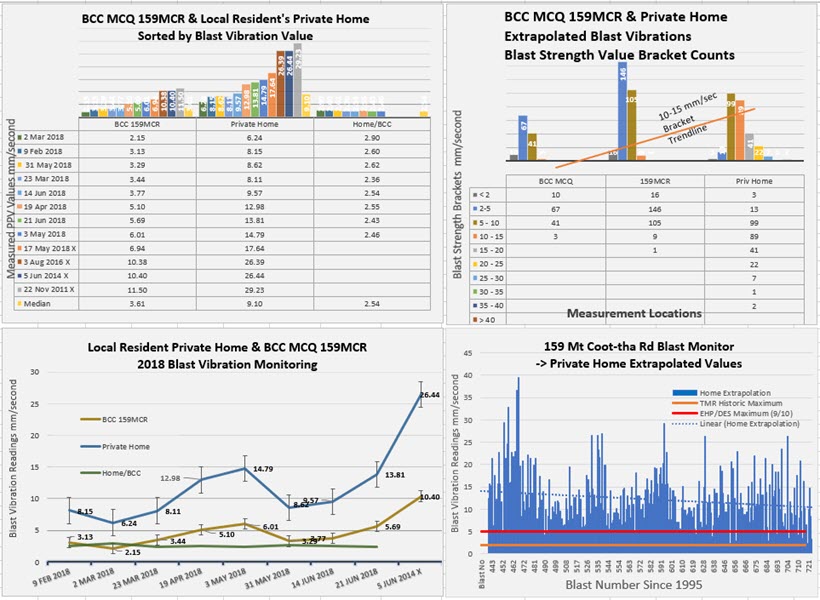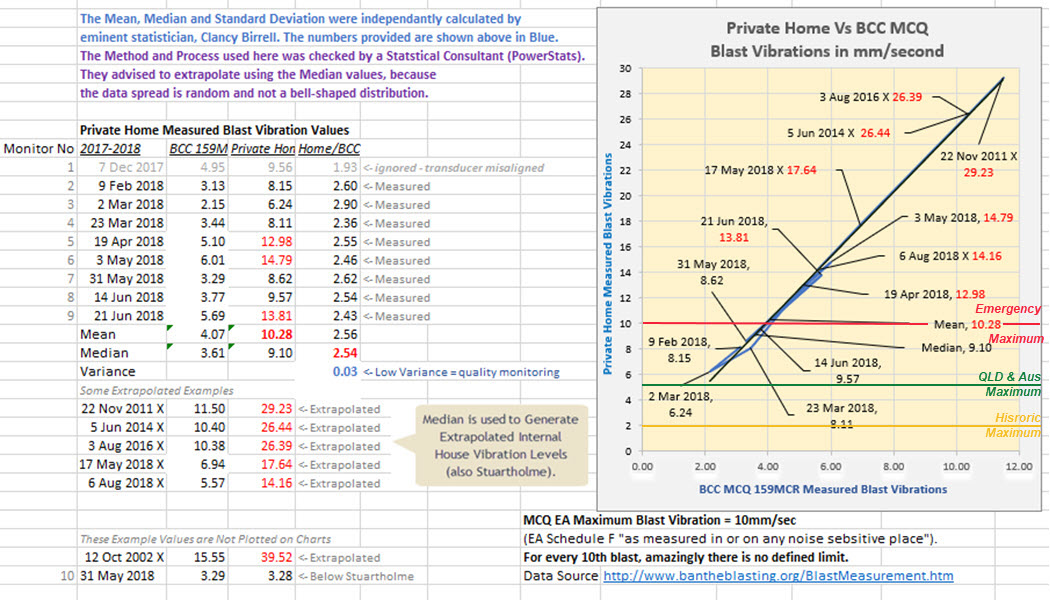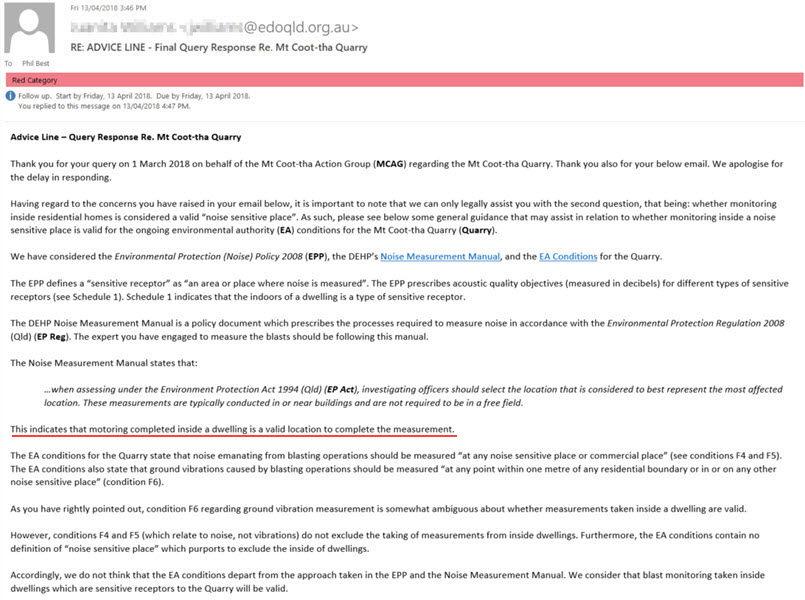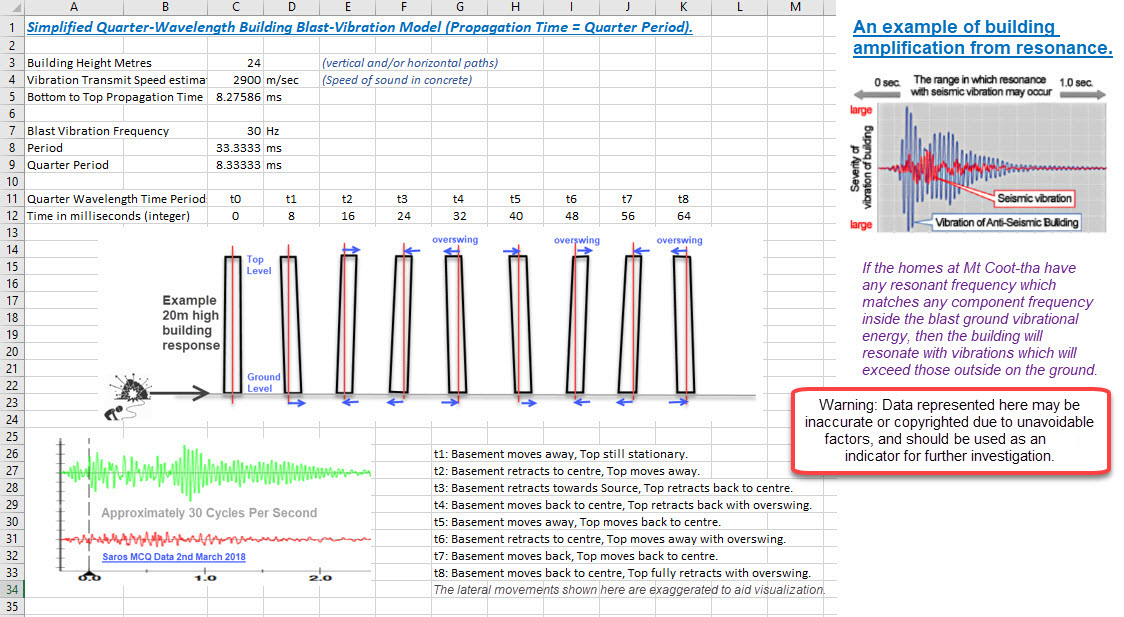Private Home Blast Vibration Monitoring
Private Home Blast Vibration Measurement & Analysis.
Validity of Private Home Monitoring Transducer and/or Microphone Attachment & Data Values.
Defined Process for using the Istantel Minimate Blast Vibration Recorder.;
Understanding what Blast Vibrations 2001-2017 were present inside Local Resident's Private Homes.
#3SSGD BCC MCQ and Private Home Blast Vibration Data.
Private Home Blast Vibration Measurement & Analysis.
Clarification that a private home is a valid monitoring location can be seen in this diagram, which combines the EPPR00447313 Schedule F6 monitoring requirements with the DERM/EHP/DES definition of a noise sensitive place.In addition to this, the EDO advised the Local Residents that the blasting conditions listed in the MCQ-EPPR, indicated the clear legality of private home blast monitoring results.
Plus we are also advised that from 2018, incidental EHP/DES departmental policy cannot easily overrule legally defined license constraints and penalties.
Hence this indicates that the data obtained from Private Home Monitoring, and indeed any noise sensitive place monitoring, is a valid MCQ-EPPR component factor.
The quarry license conditions states "in or on any noise sensitive place", which can almost mean any place in the home, but with attachment constraints.
The Validity of Private Home Monitoring Transducer and/or Microphone Attachment & Data Values
When monitoring blast vibrations in or on private homes, it is essential that the Tri-axial Transducer is securely attached to a relevant firm surface, to ensure a valid house connection.In a home with solid 75mm wide horizontal timber balustrade, then clamping the transducer to the top of the balustrade should be a valid connection.
In a house with on open staircase, then the transducer could be clamped to one of the stair treads, as long as this did not impede the staircase usage and emergency exit.
Monitoring on a patio balustrade may also be suitable, plus this can measure the overpressure blast sonic boom, however the balustrade would need to have significant density to validate the measurement. A 12mm steel balustrade system would not be recommended.
Patios and Swimming Pools commonly use Glass Balustrades, and as these are an important safety item with significant density, then monitoring is suitable if there is a solid surface.
A 90 degree 75mm or 100mm bracket could be clamped to a firm house support post, and the transducer could be bolted or clamped to the top of the bracket.
Any clamp should be light weight, so as to not alter the vibration characteristics, hence using a bolt is the preferred method.
The EHP/DES Noise Measurement Manual says: "... when assessing under the Environmental Protection Act 1994 (Qld) (EP Act), investigation officers should select the location that is considered to best represent the most affected location. These measurements are typically conducted in or near buildings and are not required to be in a free field."
Defined Process for using the Istantel Minimate Blast Vibration Recorder
We always hired the instantel from the professional blast monitoring company Saros from Milton, they configured and afterwards extracted the data from the monitor. The "Investigation Officer" must be approved as a responsible person by the other local residents and simply places the transducer before the blast. If possible this person should be either a Senior Professional Electrical Engineer "SPEE" or any type of RPEQ Engineer and would never have any direct connection to the monitor data.1. The Local Resident asks the Quarry if a blast is occurring that week, if so then they would book an Instantel Minimate Blast Monitor from Saros.
2. On the morning of the blast, if the weather looks unsuitable, then confirm with the quarry that the blast is going ahead that day.
3. Check with the Saros Staff, that the Instantel Minimate will be setup correctly for Mt Coot-tha Quarry requirements.
4. The SPEE will collect the Instantel Minimate from the Saros Lab.
5. The SPEE will proceed to the correct local residents home, clamp the Tri-Axial Transducer to a suitable horizontal house component, such as a balustrade or stair treads.
6. The SPEE will press the on/off button, activate the test and if OK Press the record button.
7. The SPEE to ensure that everybody must leave the home monitoring area, thus totally removing all other people and animals.
8. After the blast, the SPEE will press the Minimate Cancel and then the on/off buttons.
9. The SPEE will then immediately return the Minimate to the Saros Lab (no prolonged delay is allowed).
10. At a later time or date, Saros Technician will interrogate the Minimate using their Instantel software and email the Instantel report to the Local Resident and other recipients.
Understanding what Blast Vibrations 2001-2017 were present inside Local Resident's Private Homes.
In order to understand this, the Local Residents first needed to measure the blast vibrations that were actually happening inside the home, and then extrapolate this onto the received blast vibration data.They had always believed that the vibrations experienced inside the homes were much stronger than what were being measured outside at #3SSGD.
- Some of the local residents damage reports, as shown in our December 2017 mediation committee proposal report, validates their belief.
The stronger home vibration theory was also confirmed on the 3rd August 2016, when the Quarry conducted a very strong blast which measured 10.38mm/second at the #3SSGD monitoring point.
- On that same day an internal home noise measurement using a calibrated and NATA approved decibel data logger was used in a Local Residents home.
- The evidence provided by the datalogger is truly astonishing - it showed that the private local resident"s home opposite the quarry continued to vibrate and emit noise for more than 30 seconds after the blast had subsided.
- For any home to do this, can only mean that the blast effect on the home was considerably stronger, than what was being measured nearby at the #3SSGD monitoring point.
Because the Quarry Management had repeatedly refused to do any private home monitoring, no data was available until the residents were able to finance this themselves.
The Heilig blast monitoring company was asked to extend their current quarry blast monitoring process, to include local residents home (at the residents cost). However this was refused.
Hence in December 2017, a program of private house blast vibration measurements commenced, with assistance from the Local Blast Monitoring Company Saros.
The intention being to record a total of 10 Mt Coo-tha Quarry home blast vibrations, and as of the end of May 2018 the following measurements had been completed.
1H2018 #3SSGD Blast Vibration Data - Comparing BCC MCQ Vs Private Home Noise Sensitive Area Values
The Home/#3SSGD Median Value of 2.56 therefore became a best likely approximate upsize factor.
This was then used as the Extrapolation factor to calculate the unmeasured private home noise sensitive area data.
#3SSGD Private Home Extrapolated Blast Vibration Data
Top of Page
Private Home Blast Vibration Measurement & Analysis.
Validity of Private Home Monitoring Transducer and/or Microphone Attachment & Data Values.
Defined Process for using the Istantel Minimate Blast Vibration Recorder.;
Understanding what Blast Vibrations 2001-2017 were present inside Local Resident's Private Homes.
#3SSGD BCC MCQ and Private Home Blast Vibration Data.



